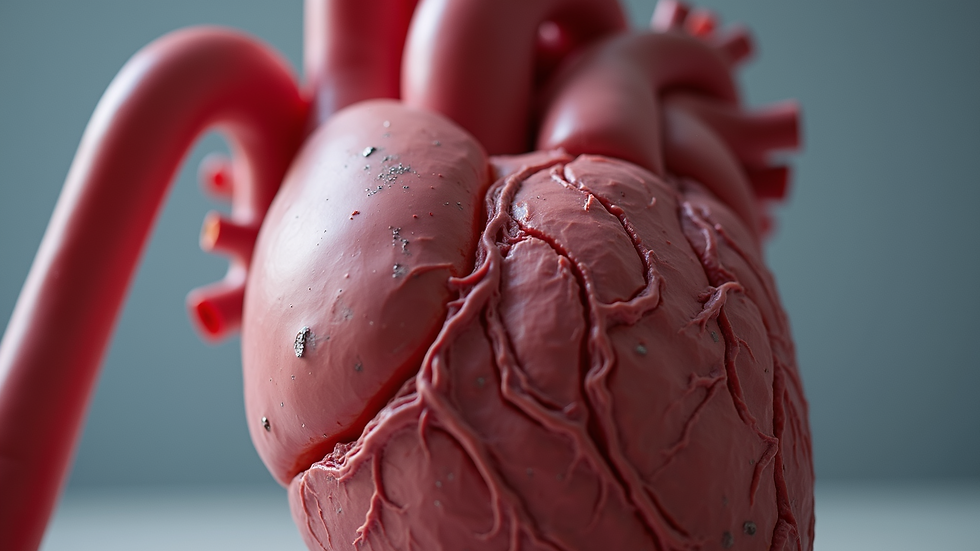Mastering Cardiopulmonary Concepts: Tutoring Made Easy
- cardiopulmauntie
- Aug 16
- 5 min read
Understanding cardiopulmonary concepts can be a daunting task for many students. The heart and lungs are vital organs, and their functions are complex. However, with the right approach, mastering these concepts can be both achievable and enjoyable. This blog post aims to provide practical tips and strategies for effective tutoring in cardiopulmonary topics.
Whether you are a tutor or a student seeking to improve your understanding, this guide will help you navigate the intricacies of cardiopulmonary physiology and pathology.
The Importance of Cardiopulmonary Knowledge
Cardiopulmonary knowledge is essential for various fields, including medicine, nursing, and respiratory therapy. Understanding how the heart and lungs work together is crucial for diagnosing and treating patients.
Here are a few reasons why mastering these concepts is important:
Patient Care: Knowledge of cardiopulmonary functions helps in providing better care to patients.
Critical Thinking: Understanding these systems enhances critical thinking skills, which are vital in healthcare settings.
Career Opportunities: Proficiency in cardiopulmonary concepts can open doors to various career paths in healthcare.
By grasping these concepts, students can build a strong foundation for their future careers.
Key Concepts in Cardiopulmonary Physiology
To effectively tutor cardiopulmonary concepts, it is essential to cover the key areas of physiology. Here are some fundamental topics to focus on:
1. Anatomy of the Heart and Lungs
Understanding the anatomy of the heart and lungs is the first step in mastering cardiopulmonary concepts.
Heart Structure: The heart consists of four chambers: the right atrium, right ventricle, left atrium, and left ventricle.
Lung Anatomy: The lungs are divided into lobes, with the right lung having three lobes and the left lung having two.
Visual aids can be very helpful in this section. Consider using diagrams or models to illustrate the anatomy clearly.
2. Blood Flow Through the Heart
Explaining how blood flows through the heart is crucial.
Oxygenated vs. Deoxygenated Blood: Oxygenated blood flows from the lungs to the left atrium, while deoxygenated blood returns from the body to the right atrium.
Circulation Pathways: Discuss the systemic and pulmonary circulation pathways.
Using flowcharts can simplify this concept for students.
3. Gas Exchange in the Lungs
Gas exchange is a vital process that occurs in the lungs.
Alveoli Function: The alveoli are tiny air sacs where oxygen and carbon dioxide are exchanged.
Diffusion Process: Explain how gases move from areas of high concentration to low concentration.
Demonstrating this process with simple experiments or animations can enhance understanding.
4. Respiratory Mechanics
Understanding how breathing works is essential for grasping cardiopulmonary concepts.
Inhalation and Exhalation: Discuss the mechanics of inhalation and exhalation, including diaphragm movement.
Lung Volumes: Introduce the different lung volumes, such as tidal volume and vital capacity.
Using models or simulations can make this topic more engaging.
Effective Tutoring Strategies
Now that we have covered the key concepts, let’s explore some effective tutoring strategies.
1. Use Visual Aids
Visual aids can significantly enhance understanding.
Diagrams and Charts: Use diagrams to illustrate complex processes.
Videos and Animations: Incorporate videos that demonstrate cardiopulmonary functions.
Visual aids cater to different learning styles and can make learning more interactive.
2. Encourage Active Participation
Encouraging students to participate actively can improve retention.
Ask Questions: Pose questions throughout the session to engage students.
Group Discussions: Facilitate group discussions to encourage collaboration.
Active participation helps students feel more involved in their learning process.
3. Simplify Complex Concepts
Breaking down complex concepts into simpler parts can aid understanding.
Use Analogies: Relate cardiopulmonary functions to everyday experiences.
Step-by-Step Explanations: Provide step-by-step explanations for processes like gas exchange.
Simplifying concepts can make them more accessible to students.
4. Provide Real-Life Examples
Real-life examples can help students connect theory to practice.
Clinical Scenarios: Discuss clinical scenarios that illustrate cardiopulmonary concepts.
Case Studies: Use case studies to analyze patient situations.
Real-life examples make learning relevant and engaging.
Assessing Understanding
Assessing students’ understanding is crucial for effective tutoring.
1. Quizzes and Tests
Regular quizzes can help gauge understanding.
Short Quizzes: Use short quizzes to test knowledge on specific topics.
Practice Tests: Provide practice tests to prepare for exams.
Quizzes can reinforce learning and identify areas that need further review.
2. Feedback and Reflection
Providing feedback is essential for improvement.
Constructive Feedback: Offer constructive feedback on quizzes and assignments.
Reflection Activities: Encourage students to reflect on what they have learned.
Feedback helps students understand their strengths and areas for growth.
Resources for Further Learning
Providing students with additional resources can enhance their learning experience.
1. Recommended Textbooks
Suggesting textbooks can provide students with in-depth knowledge.
"Cardiopulmonary Anatomy and Physiology": A comprehensive resource for understanding the anatomy and physiology of the heart and lungs.
"Respiratory Care: Principles and Practice": A practical guide for respiratory care professionals.
Textbooks can serve as valuable references for students.
2. Online Courses and Videos
Online courses and videos can supplement learning.
MOOCs: Massive Open Online Courses offer free or low-cost courses on cardiopulmonary topics.
YouTube Channels: Recommend educational YouTube channels that focus on cardiopulmonary physiology.
Online resources provide flexibility and accessibility for students.
The Role of Technology in Tutoring
Technology can enhance the tutoring experience in various ways.
1. Interactive Learning Tools
Interactive tools can make learning more engaging.
Simulations: Use simulations to demonstrate cardiopulmonary functions.
Apps: Recommend apps that offer quizzes and flashcards for studying.
Technology can provide a dynamic learning environment.
2. Virtual Tutoring Platforms
Virtual tutoring platforms can expand access to tutoring.
Video Conferencing: Use video conferencing tools for remote tutoring sessions.
Online Whiteboards: Utilize online whiteboards for collaborative learning.
Virtual platforms can connect tutors and students regardless of location.
Building Confidence in Students
Building confidence in students is essential for their success.
1. Celebrate Achievements
Recognizing achievements can boost confidence.
Acknowledge Progress: Celebrate small milestones and improvements.
Positive Reinforcement: Use positive reinforcement to encourage students.
Celebrating achievements fosters a positive learning environment.
2. Encourage a Growth Mindset
Promoting a growth mindset can help students overcome challenges.
Emphasize Effort: Encourage students to focus on effort rather than perfection.
Teach Resilience: Help students develop resilience in the face of difficulties.
A growth mindset empowers students to embrace challenges.
Final Thoughts on Mastering Cardiopulmonary Concepts
Mastering cardiopulmonary concepts may seem challenging, but with the right strategies, it can be an enjoyable journey.
By focusing on key concepts, employing effective tutoring strategies, and utilizing resources, both tutors and students can achieve success.
Remember, the goal is to make learning engaging and accessible. With patience and creativity, anyone can master the intricacies of cardiopulmonary physiology and pathology.

Embrace the challenge, and enjoy the process of learning and teaching cardiopulmonary concepts. Your efforts will not only benefit you but also the future patients you will serve.


Comments